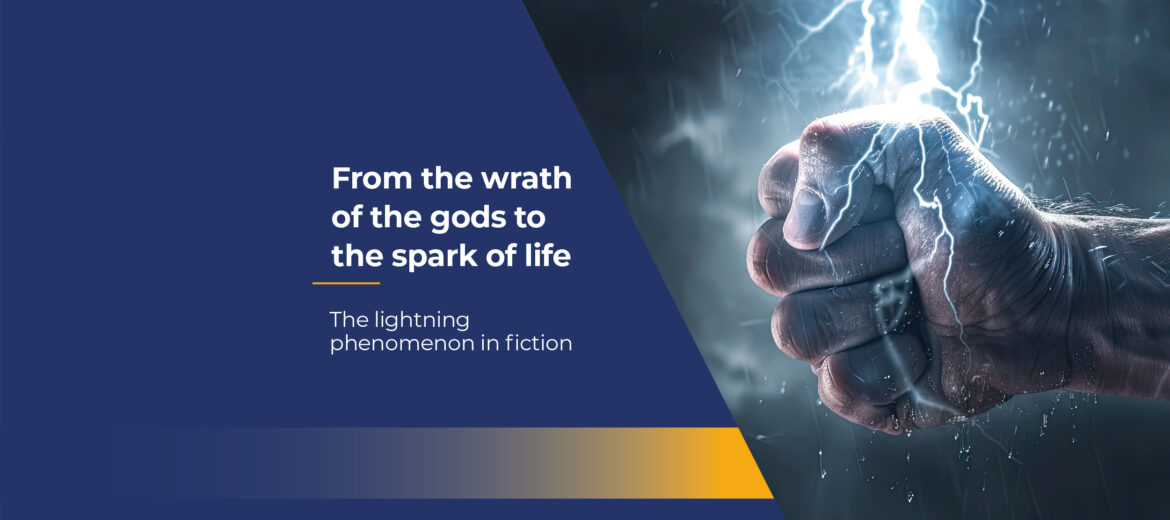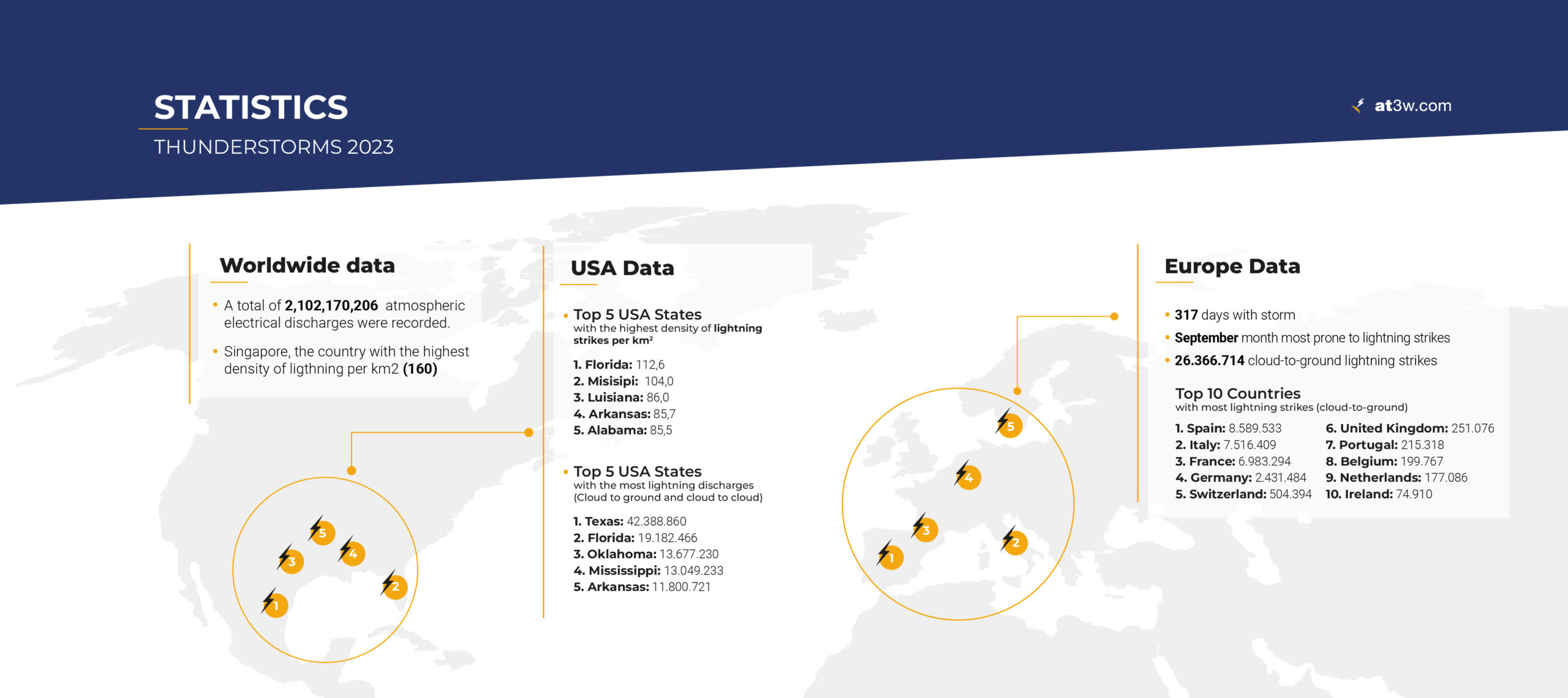The phenomenon of lightning has been an endless source of inspiration and fear in mythology, ancient culture, literature and film over the centuries. Its awesome power and ability to illuminate the night sky have led civilisations to attribute mystical and divine meanings to it before they knew the physics behind this atmospheric phenomenon. From the gods of thunder in mythology to its symbolism in classical and contemporary literature, lightning has left an indelible mark on the human imagination.
The study of lightning and related phenomena involves different branches of physics, from atmospheric to plasma to quantum electrodynamics. The exact mechanism by which lightning is generated in clouds is not fully understood, nor is the mechanism by which lightning strikes a particular point. However, despite the difficulties in studying these atmospheric discharges, more and more information is becoming available from observations and measurements.
The Lightning Phenomenon in Fiction – From Mythology to Ancient and Modern Literature
Until the beginning of the study of lightning phenomena, their nature has inspired fascination and fear in the human race. In Greek mythology, Zeus, the king of the gods, is often associated with lightning. According to Hesiod in his Theogony, Zeus uses the thunderbolt as his main weapon, bestowed by the Cyclops as a symbol of his supreme authority and power (Hesiod, Theogony, line 501-506). This element becomes an instrument of divine justice and retribution, manifesting Zeus’ dominion over heaven and earth.
Norse mythology also presents a powerful figure associated with lightning: Thor, the god of thunder. In Snorri Sturluson’s Edda Prosaica, Thor wields a hammer called Mjölnir, which produces lightning when thrown (Sturluson, Edda Prosaica, Gylfaginning, chapter 20). This hammer symbolises not only the destructive power of lightning but also protection and strength, essential attributes for a god protector of mankind and the gods.
In the Vedic literature of ancient India, lightning also figures prominently. Indra, the sky god and king of the devas, wields the vajra, a lightning weapon, to defeat demons and protect the cosmic order (Rig Veda, Mandala 1, Sukta 32). The vajra represents not only Indra’s invincible strength but also spiritual enlightenment and purity.
The cultural impact of the thunderbolt extends beyond mythology and infiltrates ancient and modern literature. In Homer’s The Iliad, Zeus uses lightning to show his favour or displeasure, directly affecting human events (Homer, The Iliad, book 8, line 75-80). The use of lightning in this epic underlines divine intervention in human affairs and destiny.
Roman literature also deals with the theme of lightning. In Virgil’s The Aeneid, Jupiter, the Roman equivalent of Zeus, uses lightning to impose his will and guide the fate of Aeneas (Virgil, The Aeneid, book 1, line 223-233). This work reflects the Roman belief in the divine power of the gods and their influence on the fate of mortal beings.
These examples demonstrate how lightning has been a multifaceted symbol in mythology, culture and literature. From representing divine power to serving as a symbol of transformation and destiny, lightning continues to be a powerful and evocative force in human narrative.
It’s alive! – Galvanism and the spark of life in Frankenstein or Modern Prometheus
Galvanism is a theory of the Italian physician Luigi Galvani (1737-1798) according to which the brains of animals produce electricity which is transferred by the nerves, accumulated in the muscles and triggered to move the limbs. After the publication of his book De viribus electricitatis in motu musculari commentarius in 1791, the galvanic phenomenon became public, known throughout the world and began to be studied by several scientists.
This unique theory swept through European university campuses in the late 18th and early decades of the 19th century and led to a series of early experiments on animals (and even human cadavers) that can be seen as a remote ancestor of the modern cardiac defibrillator.
An unusually cold summer, a meeting between romantic intellectuals in Switzerland and a challenge were enough for Mary Shelley to apply the theory of galvanism and electricity as the spark to the story of a doctor with a strong existential crisis and a God complex, who animated a creature made from scraps, from pieces of other dead people, in Frankenstein or The Modern Prometheus, a work published in 1818.
Although it is established in the collective imagination that The Creature comes to life after an atmospheric discharge, it is not until the 1931 film version that the use of lightning as a catalyst for the animation of the monster’s body (and subsequent companion) is made explicit, given that the novel only refers to a thunderstorm outside the laboratory. Lightning, in any case, is a constant throughout the text, as an allegory of enlightenment.
1.21 gigawatts – Lightning energy as a catalyst for time travel in Back to the Future
For an entire generation, the use of lightning within a work of fiction is inextricably linked to the convoluted plan that Doc, the epitome of the mad scientist who co-starred in Back to the Future (Robert Zemeckis, 1985), hatched in 1955 to return a teenager to the future after an accidental (and accidental) time travel.
In short, a scientist creates a time machine in a car. To work, the vehicle must reach a certain speed (142 kilometres per hour) and produce, through a nuclear reaction, 1.21 gigawatts of energy. Travelling back to 1955, the Doctor’s version of the past informs Marty that the only available source of energy is an atmospheric discharge, an unpredictable phenomenon.
In this case, the prediction of a storm and the exact location of the lightning strike is dictated by the history of the small town where the action takes place. During the night of a particular day, lightning strikes the clock tower, causing a malfunction. Although it is now possible to assess the conditions necessary for a lightning strike to prevent accidents, it is impossible to predict the exact spot where lightning will strike.
In the film, only the energy produced by the lightning strike (which in the later instalments of the trilogy operates with a futuristic nuclear fusion process) is exploited, since the mechanics of time travel are produced by the reaction activating an invention, the flux capacitor, the mechanism of which is never explained.
While not all atmospheric discharges are equal – lightning can reach and exceed the 1.21 gigawatts required in the film – channelling that energy to a specific point to achieve the reaction is within the realm of fictional licensing.
The fastest mal alive – Lightning as an allegory of speed
In addition to its power, lightning has also become an allegory for speed. No wonder, since the average speed of lightning reaches 440 kilometres per second.
Within fiction, one character has been intimately linked to the figure of the lightning bolt almost since its conception. Created in 1956 and modelled after another hero of the same name, the second version of the Flash, the fastest superhero, acquires his powers after suffering an atmospheric discharge which, mixed with a combination of chemicals, gives him the power to travel at great speeds.
This origin story has been maintained as canon in subsequent versions, in comics and within film and television. It is precisely in the most recent film version, The Flash (Andy Muschietti, 2023) when, in addition to the canonical origin, an attempt is made to repeat the phenomenon in a laboratory using a very sui generis version of Benjamin Franklin’s kite experiment, only by launching an upward leader to attract the lightning.



